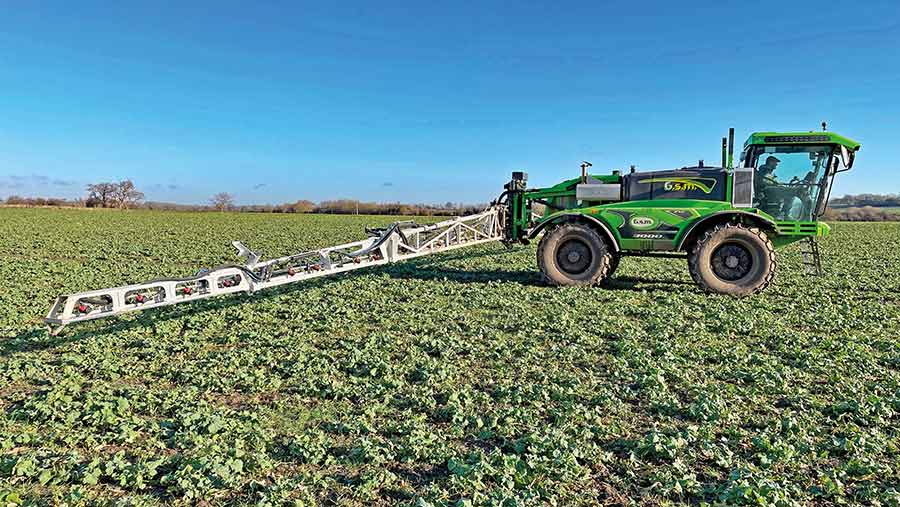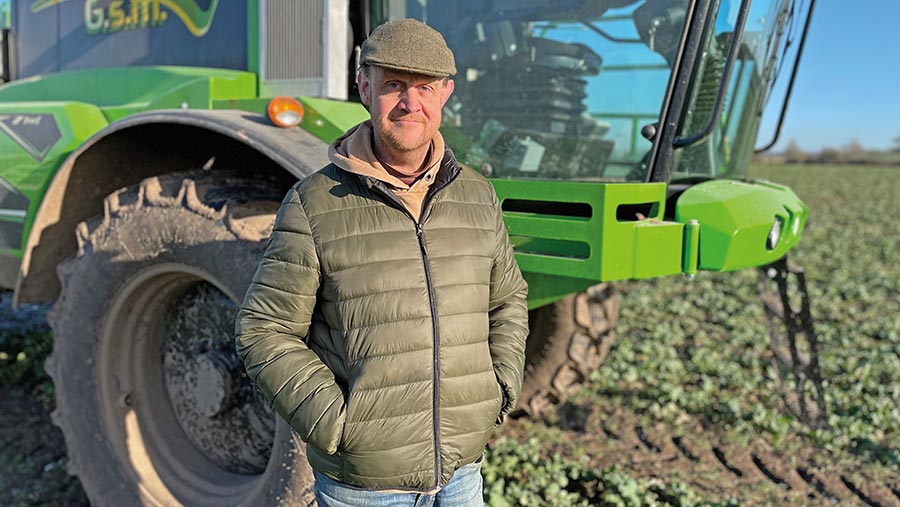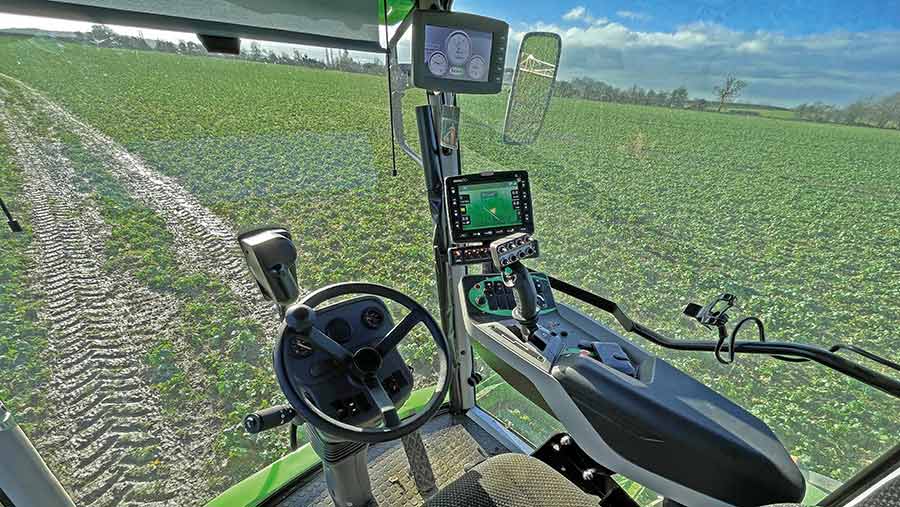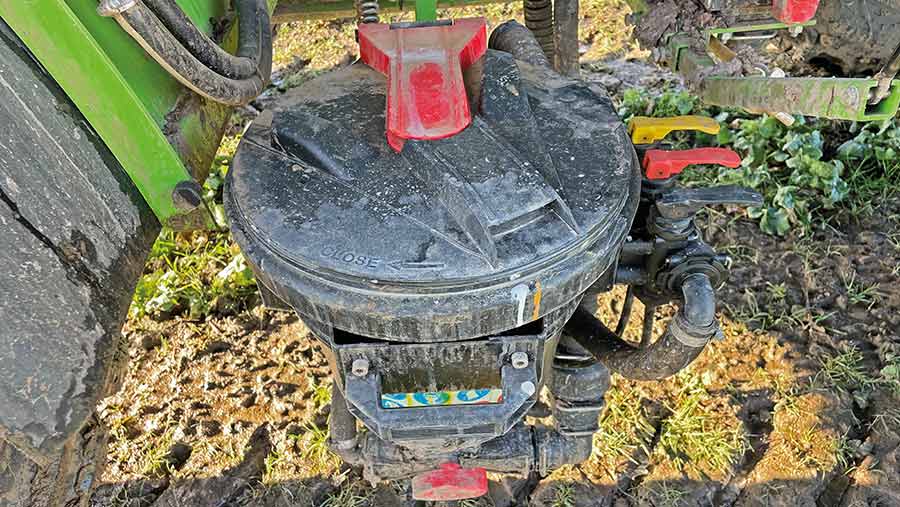Driver’s view: Rob Hadley rates his Grim self-propelled sprayer
 © James Andrews
© James Andrews Never one to shy away from a lesser-known brand, Warwickshire mixed farmer Rob Hadley has taken a punt on the first Italian-built Grim self-propelled sprayer to be brought into the UK.
Although an established entity in Europe and boasting sales in far-flung locations such as North America, Japan and Australia, the firm has never got a foothold here.
However, thanks to a recent deal struck with Berwickshire-based importer Merse Agriculture, it has finally made it.
See also: Downsized sprayer has plenty of upsides for Cornish contractor
Mr Hadley’s GSM 3000 is the largest of the entry-level 7-series, featuring a 3,000-litre fibreglass tank, 24m Pommier aluminium boom, and a four-cylinder FPT engine packing 170hp.

Rob Hadley © James Andrews
Unlike most self-propelled machines that use a pure hydrostatic driveline with a motor on each wheel, the 7-series adopts a telehandler-style setup, with a single hydraulic motor driving conventional front and rear axles.
We caught up with him to see how the sprayer has settled in after its first few months on the farm.
What made you choose a Grim sprayer?
Since my first petrol-powered Frazier Agribuggy in the mid-1980s, I’ve been a huge fan of low ground-pressure self-propelled sprayers.
I’ve had seven in total, only once breaking with tradition when I thought I could save some money by running a 3,500-litre trailed Lemken.
It was an impressive machine, but I missed the manoeuvrability and it made too much mess in the wet.
My last self-propelled was a Bargam Grimpeur 2500, which is built in the same area as the Grim. It was a great sprayer, but I’d had it for almost 10 years and thought it could do with upgrading.
I’d have happily gone for the same again, but Bargam has moved away from small sprayers, so I had to rethink.
I was already dealing with Craig Burn from Merse for parts and backup for the Grimpeur, and when he showed me the Grim, I was immediately interested.
The basic format of the two sprayers is the same – lightweight, hydrostatic transmission with conventional axles and a simple spray pack – but I thought the Grim’s build quality was better and I liked the fact that the rear-mounted engine gives it a near 50/50 weight distribution.
Although I can see the appeal of the ground clearance you get with a full hydrostatic machine, I much prefer the positive drive of mechanical axles.
The Bargam/Grim approach gives the best of both worlds, as you have a smooth joystick controller in the cab with durable differentials and driveshafts doing the hard work.
Granted, there’s less ground clearance, but I never had a problem spraying oilseed rape and maize with the Bargam and it should be the same story with the Grim.
After making an appearance at Cereals in June, the sprayer came to me for a demo.
By that point I was already well down the path of committing to buy it, so when Craig dropped it off, it stayed put and the Bargam went back as part exchange.
Once it was gone, I totted up how much it had cost me to run over the 10 years I’d had it. Including depreciation, repairs and fuel, the figure came to well under £5,000/year, which I think is a bargain.
It just goes to show that you don’t need to buy a machine from the best-known brands to get low running cost, decent backup and a good resale value. Hopefully I’ll have the same result with the Grim.
Specs
Grim 7-series GSM 3000
- Engine 4.5-litre, four-cylinder FPT
- Power 170hp
- Transmission 50kph Danfoss hydrostatic/mechanical
- Axles Dana Spicer
- Tank 3,000-litre fibreglass
- Boom 24m Pommier aluminium twin-fold with 13-section auto shut-off
- Spray controller Arag Delta 80
- Pump Comet 300 litre/min
- Unladen weight 6.8t
- Fully laden weight 9.9t
- Starting price £170,000
Did you spec any extras?
As it was a demo sprayer, it had already been specced and assembled before I’d bought it. However, I don’t think there’s anything else I would have added if I’d had the chance.
The boom is running on 13 sections – four more than I had on the Grimpeur – and it has GPS-guided auto-section control, which is a novelty for me.
For the first few runs I had to sit on my right hand to stop me flicking the switches manually, but now that I’m used to it, I wouldn’t want to go back.
It’s also fitted with a boom recirculation system and the nozzles have air on-off valves, so chemical is always at the end nozzles as soon as you start off.
In the cab, there’s an Arag Delta 80 spray controller, which I find simple to setup and use.

© James Andrews
This is also home to a basic GPS system that’s accurate enough for spraying grass – you just line up the coloured-in bouts on the screen and it usually works out well.
There’s no autosteer fitted, but we’re still old-school and drill with markers, so I don’t see much of a use for it yet.
That said, it would probably be like the automatic section control, and I’d find it very handy once I’d got used to it.
How has it performed?
I’ve only clocked up about 140 hours, so it’s a bit early to comment on reliability. However, it feels like it will be a sound machine and I’m already enjoying how smooth and quiet it is to drive.
There might be 10 years between them, but the Grim seems significantly better put together – a bit more Maserati than Alfa Romeo if you will.
When I first had the Bargam, there were several exposed wires and connectors that got corroded by liquid fertiliser, causing a host of electrical gremlins.
After fixing these and carrying out a few modifications, it turned out to be a reliable machine, but it wasn’t much fun at the time.
In contrast, the Grim’s wiring seems much better organised, and I haven’t seen any signs of trouble yet.
Weight distribution is also superior, thanks largely to the fact that the tank butts right up to the cab and the engine sits over the rear wheels.
The Bargam had a 60:40 rear-to-front weight distribution, meaning the steering could go a bit light with a full tank, but the Grim is nearer 50/50, and it feels more planted as a result.
Another contributing factor could be the fact that I ran the Bargam on large flotation tyres with a bar tread, while the Grim is currently on 540/65 R34s with tractor lugs that offer considerably more bite.
It’s also slightly lighter so, even though I can carry an extra 500 litres, the fully laden weight is about the same.
Ride quality is another strong point, which is a result of the combined hydraulic and air suspension.
I’m not the fastest sprayer operator out there, but it seems to glide along at 12-13kph, and the damping is well sorted so you don’t get any of that Househam Air-Ride bounce.
I had to spray some ploughed ground just after it arrived, which I was reluctant to subject my brand-new machine to, but I needn’t have worried as it dealt with it easily.
On the ends, the four-wheel steering makes it easy to turn cleanly into the headland tramline, without the back end making a separate set of wheel marks.
To start with, I had to watch that I didn’t turn it off as I got there, because the floor switch is in the same place as the old Bargam’s master on-off.
The cab is simple, but there’s plenty of space, it comes with a fridge/warming box and it’s quiet – another bonus of the engine being lumped at the back of the machine.

© James Andrews
I also like the small clean-clothing locker next to the steps, which means I can grab my kit without having to grovel under the boom, like you do on so many.
One feature that’s been surprisingly impressive is the aluminium Pommier boom, which is very stable and doesn’t suffer from the usual pitching and yawing.
It’s a big step up from the steel Gambetti boom I had before, which required regular levelling and had a habit of jamming when folding it away on sloping ground.
What could be improved?
The airplane toilet-style induction hopper is great in many ways, and it has a wet wall rinsing system that keeps it cleaner than one with individual jets.
However, it isn’t big enough to hold the contents of a full 20-litre glyphosate can and leave sufficient room for washing it out.

© James Andrews
I think Craig from Merse is going to provide a larger 30-litre version though, which will solve the problem.
Another minor design flaw is the side panel for the filling station – I’m not the tallest, but it barely lifts high enough to clear my head. For any loftier individuals, it would be a bit annoying.
There is also a slightly naff fabric tube acting as cable conduit in the corner of the cab, which lets the side down a bit.
The only upgrade I’m considering in the short term is wheels.
It came to me with a set of 540 intermediate tyres, which have travelled well this autumn/winter and haven’t seemed like a backward step from the flotation tyres on the Bargam.
I could keep these on all season and put up with wider tramline wheel marks, but I think I’ll take the plunge and order some row crops.
I’m currently hunting around to see if I can get some for a reasonable price.
Likes and gripes
✔ Well balanced
✔ Tough mechanical driveline
✔ Smooth and quiet
✔ Good build quality
Gripes
✘ Standard induction hopper too small for 20-litre can
✘ Side panel doesn’t lift high enough

